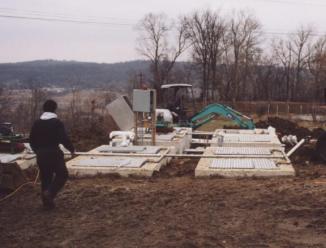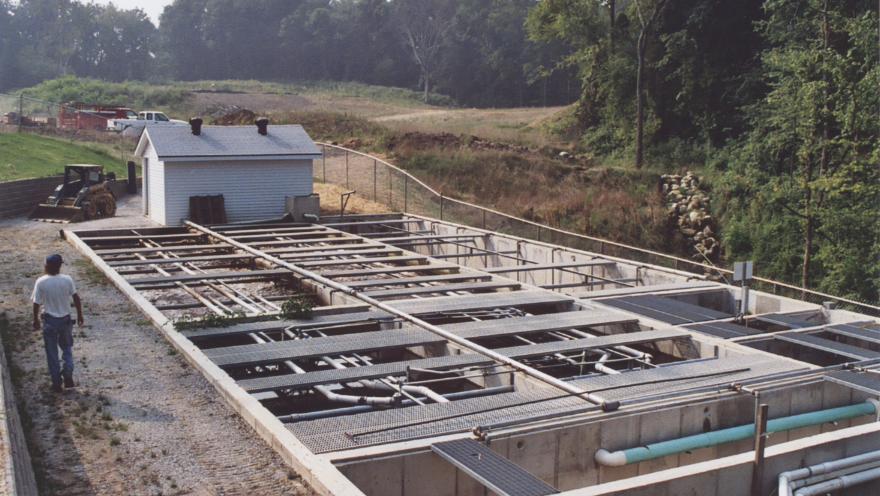|
What is a “package plant?”
The term “package plant” originated from the fact that these types of treatment plants were constructed and assembled at a factory and then shipped and installed “pre-packaged” as a complete unit. They became popular during the 1960’s and are still being installed today. Typically they were constructed of 1/4” plate steel and divided into several components. The components always included an aeration tank where most of
the treatment occurs and a clarifier for settling. Some systems included a sludge waste compartment and chlorine contact tank. Package plant tanks would be shipped on a flat bed truck and off-loaded with a crane and set on a poured-in-place concrete slab. Several lengths of rebar would extend up through the slab which would be welded to the tank to prevent floatation. Another popular tank material is precast concrete. Precast systems can be a
single tank divided into compartments or they can be modular for larger systems. Typical precast concrete tank dimensions are 6’-10” x 12’-10” or 7’ x 15’. These tanks are cast at the concrete tank manufacturer facility and are shipped on a boom type truck for off-loading. The piping and equipment is generally installed at the installation site after the tanks have been set.
|
What is an extended aeration treatment plant?
Extended aeration is an aerobic treatment process where there is a lengthy detention time to oxidize the sewage. Typical detention time for the conventional aeration treatment process is 8 hours. Detention time for extended aeration is 24 hours. Extended air systems can effectively operate with detention times ranging from 12 to 48 hours. Extended aeration treatment is very thorough with nearly complete oxidation of the organic material taking place.
If the system is properly designed nitrification also occurs in extended aeration systems. Extended aeration systems have a high sludge age and produce quantities of waste activated sludge which need to be removed on a regular basis. Most package treatment plants utilize the extended aeration treatment process.
Back to Top
How does sewage treatment take place in an extended aeration system?
Extended aeration is a biological treatment process where microorganisms decompose sewage. There are five basic components necessary for the treatment process:
1. Water- provided by the facility generating the wastewater
2. Sewage- also provided by the facility; sewage is food for the microorganisms
3. Oxygen- oxygen is the energy source for the microorganisms to metabolize the sewage and convert the sewage to their own bodies and carbon dioxide
4. Microorganisms- these occur naturally in sewage and by the natural selection process certain organisms will thrive in an aeration tank
5. A tank or vessel to contain the above four components- tanks are the “home” or the habitat for the organisms to live in and a location where treatment takes place
There must be a balance of the above 5 components in order for proper treatment to occur. The design of the system is critical to its performance and achieving the desired outcome of wastewater treatment. The microorganisms use sewage for food and oxygen supplied by the blower for energy. They will metabolize the sewage and oxygen and assimilate a portion of the sewage into their own bodies. They will reproduce more of themselves and provide inert,
inoffensive by-products of carbon dioxide and water. The population of microorganisms will be controlled by the amount of food and air available, and the time available to use it. Too little or too much of any of these variables will upset the balance of the system and reduce the quality of the treatment.
Back to Top
What are some other major components in package plants?
· Most systems have a trash trap ahead of them. The trash trap collects and settles out heavy material and holds back grease. Food service facilities should also have a grease interceptor ahead of the trash trap. Some larger systems have a
grinder called a comminutor at the head of the systems in place of a trash trap. Some systems have grinder pumps at the head of the system, either in a lift station or flow equalization tank.
· Flow equalization tanks are often utilized to reduce flow surges and peak flows. Extended aeration systems operate better when flows are low and constant versus having numerous high peaks throughout the course of the day. Flow equalization tanks
pump the sewage to the aeration tank and usually have a means to regulate the forward flow rate. This may done with valves or a flow control box.
· Sludge waste tanks are provided on larger systems to have a location to direct waste activated sludge to and to store it and concentrate it for later disposal by septic tank truck. All extended air systems need to waste sludge periodically. The
frequency depends on the variables such as sewage strength, flow rates, detention times, etc.
· Disinfection is generally needed in the summer months if there is a chance the public could come into contact with the treated effluent somewhere downstream. Chlorine is generally used as a disinfecting agent. Most systems use tablet type chlorine
feed systems although liquid feed systems may also be used. In order to ensure the pathogenic organisms are destroyed, a 15 minute detention time is needed in a chlorine contact tank. Ultraviolet disinfection is also used to provide disinfection. Here, the treated effluent passes through a series of bulbs that produce light in a specific range of the ultraviolet wavelength. Contact with the ultraviolet light inactivates the ability of
microorganisms to reproduce thereby rendering pathogenic organisms harmless.
· Most systems today are required to further refines the treatment process by installing a form of tertiary treatment after the secondary treatment process. A slow sand filter is considered tertiary treatment. A sand filter provides a safety net to
catch any solids which may leave the secondary treatment plant. Effluent which has been filtered is very low in suspended solids, usually from 1mg/l to 12 mg/l. There is also some added benefit from a fixed film type treatment where under some circumstances organisms attach themselves to the sand particles and provide some additional oxidation and nitrification. The surface of a sand filter will eventually become coated with a layer of biosolids through which
water can no longer penetrate. As this point is reached the filter should be taken off line and allowed to drain and dry out for cleaning. After it is dry the biomass forms a light crust which can be raked or shoveled off and disposed of in a dumpster where it will eventually be taken to an approved landfill facility. Weeds are sometimes a problem in sand filters and dormant filters may need to be covered with black plastic to kill weeds and seeds.
· Flow is directed to the sand filter by dosing pumps which are located in the dosing tank. Dosing pumps help distribute the flow over the entire surface of the sand filter. If the sand filter is running particularly well the flow may
percolate through the sand before it has a chance to spread out over the entire surface. This is OK, however it is believed that flooding the entire filter can help reduce keep weed growth during the growing season.
Back to Top
What are the mechanical components of package plants?
First and foremost is the motor and blower unit. The blower is the piece of equipment which provides air to the system and the motor drives the blower.
There are electric controls which activate the motor/blower unit, usually through a timer.
There may be a pumping station pumps ahead of the system if the sewer line reaches the treatment system at too low of an elevation. Pumps will also be present if the system has a flow equalization tank or a dosing tank. All pump systems have controls to turn them on and off. These are usually mercury level control floats which can be set at the desired “on” and “off” levels.
Air is introduced into the aeration tank through pipes called air diffuser drops. These diffuser drops extend off of the air header pipe which originates at the blower.
An air check valve is usually present at each blower to prevent any backflow of air.
Hydraulic air lifts are used in the clarifier to provide return activated sludge to the aeration tank and to skim surface scum. The sludge return air lift must be clear and operating or the system will not operate properly. It is the second most important mechanical component in the system and it is totally critical to the plant operation. The skimmer air lift helps keep the clarifier surface clear and free of scum and light debris.
Back to Top
What should a properly operating system look like?
An ideal looking extended aeration plant has a rich brown color in the aeration tank. The clarifier should have a very clear supernatant present with a visible sludge blanket under it. The supernatant depth can vary from 6” to 48”. The depth of the supernatant will fluctuate during the course of a day depending on the flow rate. Higher flow rates will cause the sludge blanket to rise, reducing the depth of the supernatant.
What does an improperly operating system look like?
Signs of insufficient treatment are a cloudy looking effluent, suspended solids in the effluent or solids settling at the outfall, a “washed out” appearance in the aeration tank, a gray or black color in the aeration tank, or a foul odor. None of these conditions are present in a properly operating system. A general lack of housekeeping at the site may indicate a lack of attention to the system and improper treatment.
General
No two treatment plants look the same or operate the same. They come in all different sizes and configurations. The majority are capable of operating quite well most of the time. Extended aeration treatment plants will operate well if they are properly sized, are not subject to inflow and infiltration and most importantly are properly maintained. Some systems are constantly overloaded and never operate properly because they simply can’t. Some
systems could operate properly with the right attention. All systems experience upsets and routine malfunctions. These upsets and malfunctions need to be recognized and corrected immediately by the maintenance personnel or operator. All treatment systems need frequent inspections and maintenance by trained personnel. Operating and evaluating package plants is part science and part art. Time and experience with these systems ultimately is the best
teacher.
Back to Top
|

|
Here is a typical steel package plant being lowered into the excavation.
|
|
Here is an example of a precast concrete tank system.
|

|
|

|
This is a poured in place concrete system.
|
Click here for more on Winelco's Design Build Capabilities
Contact: Mike Ullman
Winelco Engineering
(513) 755-8050
support@winelco.com
|